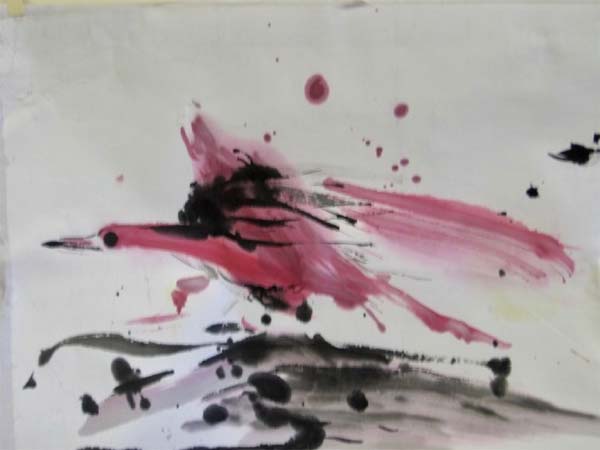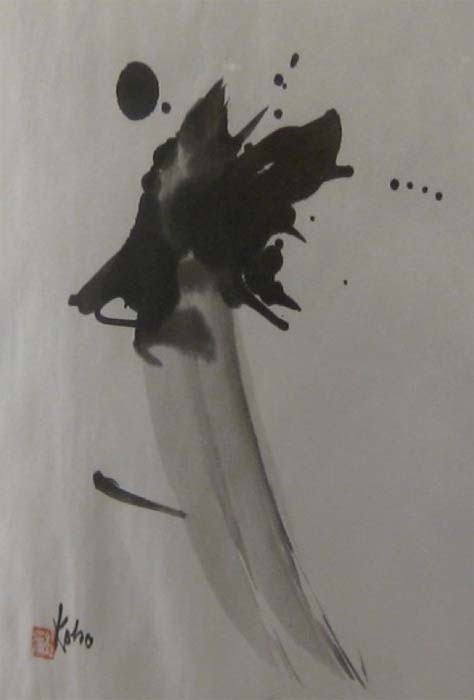s w i f t s & s l o w s: a quarterly of crisscrossings
Ikkyu & His Skeletons, Notan
Ivan Klein & Koho Yamamoto
←back or next→
Ikkyu & His Skeletons∗
Ikkyu, aka Crazy Cloud, aka Blind Ass, the much beloved Zen iconoclast
of 15th century Japan, who tore to shreds his certificate of enlightenment at the
very time it was bestowed and hit the road, knew the high and low of things.Knew the contempt with which mendicants were doled out their scraps at
the back doors of the wealthy, knew the cold wind that blew through a lonely
hermit’s hut in the mountains. – Finally, knew the pomp of an Abbot’s purple
robes as well.A drinker, a womanizer and an artist, he tried in his old age to set the
record straight on certain spiritual matters in a lengthy haibun titled “Skeletons.”It begins with a traditional set-up of the Eternal Quest:
“Filled with disgust and longing to liberate myself from the realm of
continual birth and death, I abandoned home and set off on a journey.”
The wanderer finds himself near a deserted little temple at the base of a
mountain before which is an endless field of graves. Out of this field a pitiful
skeleton arises to hip him to the Essential Doctrine of Emptiness:“All things become naught by returning
to their origin.”
In an uncanny dream, a second skeleton separates himself from his crowd
to address Ikkyu.He reiterates the Doctrine and the monk immediately counts
him as a friend.The poor spectral fellow “saw things clearly, just the way they
are.”After dark, the skeleton gang disports itself among the gravestones
while the autumn moonlight dances across the poet’s mortal face.
Under the influence of his new pals, waking and sleeping, his eyes are
wide open. He perceives the basis of philosophy, the structure of the Buddha’s
thought, the ten realms of existence, taken together, truly understood, to be no
more than dust.He further makes the bold claim
that death itself is an illusion.
An additional mirage is the belief that when the body dies,
the soul endures.
“A grave error,” says Ikkyu,
not at all inclined to kid the public along.Then he gets down to serious dharma business:
the Buddha preaching for 50 years and the smile of his follower Kashyapa
at his sermon that consisted of the display of a flower.The silent transmission of mind between them that is the bedrock of what
is called the Mahayana (Great Vehicle).With this, Ikkyu declares that he has boiled all the sutras down to their
irreducible essence and that this essence will bestow bliss.He has a second thought, thinks better of all that:
“’Writing something
to leave behind
Is yet another kind of dream.
When I awake I know that
there will be no one to read it.”
You can’t blame him for hedging his bets on existence and non-existence.
– On making any kind of wager but on the sure thing of stone silence.
And yet –
There are the poems to Lady Mori, the blind minstrel, the great love of his
last years, who could bring his old prick to life like no other. – The memory of her
superlative touch that he must have clung to even as he adeptly let go of all else
in the empty universe.
* Based on Ikkyu’s Skeletons, trans. John Stevens from Wild Ways, White Pine Press, Buffalo, NY
Notan
We perform a small service relating to a senior citizen’s adjustment in
monthly rent for our dear friend and neighbor, Koho Yamamoto. She shyly rings
our doorbell a few days later bearing one of her masterpieces of sumi-e as a gift.
Notan:
Space / balance / dark and light.
The untitled painting a pure play of these qualities,
spontaneous / austere / perfect.
Suddenly I feel stupendously rich, privileged, as if all the difficulties of life
had been lifted not only from me, but from all memories of me back to the
anxious ghetto cradle.
It seems to float lightly upward from the rice paper
at the same time as its tethered
to the utmost surety of vision.
— A companion for the rest of my days on this riven earth.
— From a series on Koho Yamamoto
←back or next→
Ivan Klein has published Toward Melville, a book of poems from New Feral Press, in July 2018. Previously published a chapbook Some Paintings by Koho & A Flower Of My Own from Sisyphus Press. Work published in the Forward, Urban Graffiti, Otoliths, and numerous other publications.
Koho Yamamoto, a master of the Japanese art of sumi-e, had a studio in Soho where she worked and taught for over thirty years. The subject of an NHK documentary, she has been profiled in the NY Times and had exhibitions at major universities and galleries in the United States. Her definitive statement of artistic method, evident in the above paintings is “these paintings come from nothingness. They are spontaneous occurrences. …Sometimes the result of space, balance and dark and light (Notan) successfully emerge in the spirit of the moment.”


